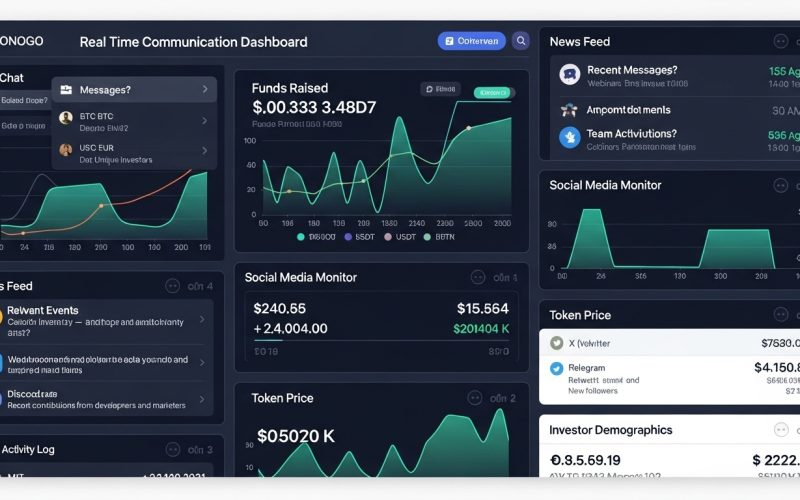Introduction
Initial Coin Offerings (ICOs) have become a game-changer in the world of fundraising. Since their rise in popularity, ICOs have enabled countless blockchain-based projects to raise millions of dollars, all while offering investors a chance to get in on the ground floor of promising ventures. For both investors and fundraisers, understanding the ins and outs of ICO development is essential to success.
In this article, we will explore the concept of ICOs, how they work, their benefits, and what investors and fundraisers need to know before diving in. Whether you’re an entrepreneur looking to launch your own ICO or an investor wanting to participate, this guide will help you navigate the complexities of ICO development.
What is an ICO?
An ICO, or Initial Coin Offering, is a method of raising capital for a new cryptocurrency project by offering investors the opportunity to purchase tokens or coins in exchange for established currencies like Bitcoin or Ethereum, or even fiat currencies like USD or EUR. ICOs are similar to Initial Public Offerings (IPOs) in the traditional stock market, but instead of offering shares in a company, ICOs provide tokens or coins that represent a utility or asset within a specific blockchain project.
ICOs are particularly popular in the cryptocurrency and blockchain space because they provide an opportunity for projects to bypass traditional funding methods such as venture capital or bank loans. By issuing tokens that can be traded on cryptocurrency exchanges, projects give investors an immediate opportunity to profit if the project succeeds.
How Does ICO Development Work?
The process of ICO development involves several key steps that both fundraisers and investors should understand. Here’s a breakdown of the essential elements:
1. Creating the Whitepaper
The whitepaper is the most crucial document in any ICO. It provides potential investors with detailed information about the project, the problem it aims to solve, how it plans to solve that problem, and the technical details of the ICO itself.
A typical whitepaper includes:
- Project overview: Describes the vision of the project and its goals.
- Problem and solution: Clearly defines the issue the project aims to address and how its solution works.
- Tokenomics: The supply, distribution, and use of tokens within the project ecosystem.
- Roadmap: A timeline of the project’s development stages.
- Team information: Backgrounds of the founders and key team members.
- Legal considerations: Details on the legal framework surrounding the ICO.
For investors, the whitepaper serves as a roadmap to understanding the project’s potential and whether it’s worth investing in.
2. Smart Contract Development
One of the most significant components of ICO development is the creation of smart contracts. Smart contracts are self-executing contracts with the terms of the agreement directly written into code. These contracts automatically execute transactions when predefined conditions are met, ensuring transparency and security in the ICO process.
Smart contracts are built on blockchain platforms like Ethereum, and they allow for the secure transfer of tokens to investors once funds are raised.
3. Token Creation
In the ICO, tokens are issued to investors in exchange for cryptocurrency or fiat money. These tokens may have different use cases within the project’s ecosystem. For example, they could represent access to a platform’s services, voting rights, or even equity in the project.
Token creation involves defining the total supply, distribution method, and any other properties that make the token valuable. The tokens are then listed on cryptocurrency exchanges for trading once the ICO ends.
4. Marketing and Community Building
A successful ICO doesn’t just rely on having a great product—it also depends on effective marketing and community engagement. Building a community around the project is critical for raising awareness and generating interest in the ICO.
Marketing efforts typically include:
- Social media campaigns (Twitter, Telegram, Reddit)
- Press releases and media coverage
- Partnerships with influencers in the crypto space
- ICO listing on platforms like CoinMarketCap, ICO Bench, and others
The more popular the project is before the ICO, the more likely it is to attract investors.
5. ICO Launch and Fundraising
Once everything is in place, the ICO launch takes place. During the launch, investors can purchase tokens at a predetermined price. ICOs are often time-limited, with investors encouraged to participate early to secure tokens at a lower price.
Fundraising goals are typically set, and the project will either meet these goals or halt the ICO if they don’t raise enough money.
6. Post-ICO Activities
After the ICO ends, the development of the project continues. This includes:
- Token distribution: Tokens are distributed to investors, and the project’s platform or service is built out as promised in the roadmap.
- Exchange listings: The tokens are listed on various cryptocurrency exchanges for trading, providing liquidity to investors.
- Ongoing marketing: Continuous efforts are made to build the user base and ensure the long-term success of the project.
Key Benefits of ICOs for Fundraisers
For fundraisers, ICOs offer a range of advantages over traditional fundraising methods. Some of the key benefits include:
1. Global Reach
ICOs allow projects to raise funds from a global pool of investors, eliminating geographical barriers that may exist with traditional funding methods.
2. Decentralized Funding
Unlike traditional venture capital funding, ICOs do not require investors to give up equity or control of the project. The funding process is decentralized and based on the community’s belief in the project.
3. Lower Barriers to Entry
Starting an ICO often requires fewer resources than traditional funding methods, making it easier for small projects or startups to raise funds. There’s no need to negotiate with venture capitalists or banks.
4. Liquidity for Investors
Once the ICO is over, tokens are often listed on exchanges, providing immediate liquidity for investors who want to cash out or trade their tokens.
Key Considerations for Investors
While ICOs present exciting opportunities for investors, they come with risks. Here are some essential factors to consider before participating in an ICO:
1. Research the Project
Before investing, always read the whitepaper and do your due diligence. Make sure the project has a solid team, a clear roadmap, and a viable product. Look for projects with transparency, clear goals, and strong community support.
2. Evaluate the Tokenomics
Understanding how tokens will be distributed and used within the ecosystem is critical. Evaluate the project’s tokenomics to ensure that the token has a real use case and isn’t just a speculative asset.
3. Watch for Red Flags
Be cautious of ICOs that make unrealistic promises or lack transparency. Red flags can include vague whitepapers, anonymous teams, or overly aggressive marketing campaigns.
4. Consider Legal and Regulatory Issues
While ICOs are legal in many jurisdictions, there are regulatory concerns in some countries. Always verify whether the ICO complies with the laws in your country, especially regarding the token’s classification and the process of investment.
Conclusion
ICO development has reshaped the way fundraising works in the blockchain and cryptocurrency industry. By offering investors early access to promising projects, ICOs allow for fast, decentralized, and global fundraising opportunities. However, like any investment, participating in an ICO requires careful research, understanding of the project, and awareness of the risks involved.
For fundraisers, launching an ICO can provide an alternative to traditional methods of raising capital, but it requires detailed planning, clear communication, and a well-thought-out roadmap. For investors, ICOs can be lucrative but come with the responsibility of being cautious and informed before jumping in.
Whether you are looking to launch an ICO or participate as an investor, understanding the development process and the associated risks will help you make better, more informed decisions.












